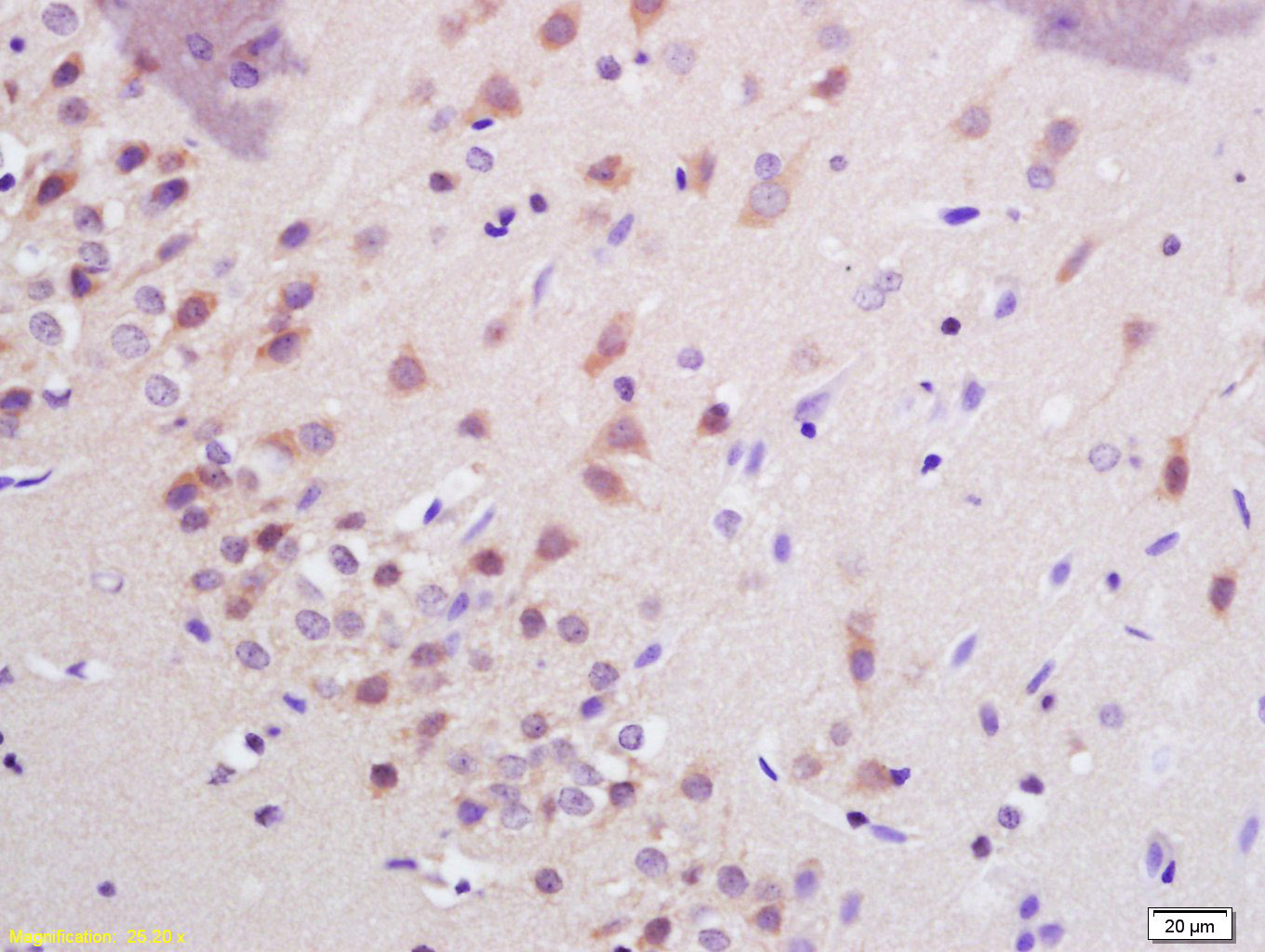SHANK3 Rabbit pAb
SHANK3 Rabbit pAb
- 产品详情
- 实验流程
- 背景知识
Application
| IHC-P, IHC-F, IF |
|---|---|
| Primary Accession | Q9BYB0 |
| Reactivity | Pig, Mouse, Dog |
| Host | Rabbit |
| Clonality | Polyclonal |
| Calculated MW | 191338 Da |
| Physical State | Liquid |
| Immunogen | KLH conjugated synthetic peptide derived from human SHANK3 |
| Epitope Specificity | 1151-1250/1741 |
| Isotype | IgG |
| Purity | affinity purified by Protein A |
| Buffer | 0.01M TBS (pH7.4) with 1% BSA, 0.02% Proclin300 and 50% Glycerol. |
| SUBCELLULAR LOCATION | Cytoplasm (By similarity). Cell junction, synapse (By similarity). Cell junction, synapse, postsynaptic cell membrane, postsynaptic density (By similarity). Note=Postsynaptic density of neuronal cells (By similarity). |
| SIMILARITY | Contains 6 ANK repeats. Contains 1 PDZ (DHR) domain. Contains 1 SAM (sterile alpha motif) domain. Contains 1 SH3 domain. |
| SUBUNIT | May homomultimerize via its SAM domain (By similarity). Interacts with DLGAP1/GKAP, MGLUR1A, MGLUR5 C-termini via its PDZ domain (By similarity). Interacts with HOMER1, HOMER2, HOMER3 and CTTN/cortactin SH3 domain (By similarity). Is part of a complex with DLG4/PSD-95 and DLGAP1/GKAP. Interacts with DBNL. Interacts (via PDZ domain) with PROSAPIP1 (via C-terminus) (By similarity). Interacts with BAIAP2. |
| DISEASE | Defects in SHANK3 are the cause of schizophrenia type 15 (SCZD15) [MIM:613950]. SCZD15 is a complex, multifactorial psychotic disorder or group of disorders characterized by disturbances in the form and content of thought (e.g. delusions, hallucinations), in mood (e.g. inappropriate affect), in sense of self and relationship to the external world (e.g. loss of ego boundaries, withdrawal), and in behavior (e.g bizarre or apparently purposeless behavior). Although it affects emotions, it is distinguished from mood disorders in which such disturbances are primary. Similarly, there may be mild impairment of cognitive function, and it is distinguished from the dementias in which disturbed cognitive function is considered primary. Some patients manifest schizophrenic as well as bipolar disorder symptoms and are often given the diagnosis of schizoaffective disorder. |
| Important Note | This product as supplied is intended for research use only, not for use in human, therapeutic or diagnostic applications. |
| Background Descriptions | SH3 and multiple ankyrin repeat domains 1-3 (Shank1-3) of the Shank/ProSAP family are molecular scaffolds in the postsynaptic density (PSD). The PSD is an electron-dense structure underneath the postsynaptic plasma membrane of excitatory synapses that anchors and clusters glutamate receptors opposite to the presynaptic neurotransmitter release site. Shank proteins contain PDZ modular domains that coordinate the synaptic localization of ion channels, receptors, signaling enzymes, and cell adhesion molecules. The PDZ domain mediates protein-protein interactions via the recognition of a conserved sequence motif at the C-terminus of their target protein(s). Shank recruits betaPIX and PAK to spines to regulate postsynaptic structure and interacts with NMDA receptor and metabotropic glutamate receptor complexes. Transcript splice variation in the Shank family influences the spectrum of Shank-interacting proteins in the PSDs of adult and developing brain to ensure normal development. |
| Gene ID | 85358 |
|---|---|
| Other Names | SH3 and multiple ankyrin repeat domains protein 3, Shank3, Proline-rich synapse-associated protein 2, ProSAP2, SHANK3, KIAA1650, PROSAP2, PSAP2 |
| Target/Specificity | Expressed in the cerebral cortex and the cerebellum. |
| Dilution | IHC-P=1:100-500,IHC-F=1:100-500,IF=1:100-500 |
| Storage | Store at -20 °C for one year. Avoid repeated freeze/thaw cycles. When reconstituted in sterile pH 7.4 0.01M PBS or diluent of antibody the antibody is stable for at least two weeks at 2-4 °C. |
| Name | SHANK3 |
|---|---|
| Synonyms | KIAA1650, PROSAP2, PSAP2 |
| Function | Major scaffold postsynaptic density protein which interacts with multiple proteins and complexes to orchestrate the dendritic spine and synapse formation, maturation and maintenance. Interconnects receptors of the postsynaptic membrane including NMDA-type and metabotropic glutamate receptors via complexes with GKAP/PSD-95 and HOMER, respectively, and the actin-based cytoskeleton. Plays a role in the structural and functional organization of the dendritic spine and synaptic junction through the interaction with Arp2/3 and WAVE1 complex as well as the promotion of the F-actin clusters. By way of this control of actin dynamics, participates in the regulation of developing neurons growth cone motility and the NMDA receptor-signaling. Also modulates GRIA1 exocytosis and GRM5/MGLUR5 expression and signaling to control the AMPA and metabotropic glutamate receptor-mediated synaptic transmission and plasticity. May be required at an early stage of synapse formation and be inhibited by IGF1 to promote synapse maturation. |
| Cellular Location | Cytoplasm. Postsynaptic density. Cell projection, dendritic spine. Note=In neuronal cells, extends into the region subjacent to the postsynaptic density (PSD). |
| Tissue Location | Expressed in the cerebral cortex and the cerebellum |
For Research Use Only. Not For Use In Diagnostic Procedures.
Provided below are standard protocols that you may find useful for product applications.
BACKGROUND
SH3 and multiple ankyrin repeat domains 1-3 (Shank1-3) of the Shank/ProSAP family are molecular scaffolds in the postsynaptic density (PSD). The PSD is an electron-dense structure underneath the postsynaptic plasma membrane of excitatory synapses that anchors and clusters glutamate receptors opposite to the presynaptic neurotransmitter release site. Shank proteins contain PDZ modular domains that coordinate the synaptic localization of ion channels, receptors, signaling enzymes, and cell adhesion molecules. The PDZ domain mediates protein-protein interactions via the recognition of a conserved sequence motif at the C-terminus of their target protein(s). Shank recruits betaPIX and PAK to spines to regulate postsynaptic structure and interacts with NMDA receptor and metabotropic glutamate receptor complexes. Transcript splice variation in the Shank family influences the spectrum of Shank-interacting proteins in the PSDs of adult and developing brain to ensure normal development.
终于等到您。ABCEPTA(百远生物)抗体产品。
点击下方“我要评价 ”按钮提交您的反馈信息,您的反馈和评价是我们最宝贵的财富之一,
我们将在1-3个工作日内处理您的反馈信息。
如有疑问,联系:0512-88856768 tech-china@abcepta.com.























 癌症的基本特征包括细胞增殖、血管生成、迁移、凋亡逃避机制和细胞永生等。找到癌症发生过程中这些通路的关键标记物和对应的抗体用于检测至关重要。
癌症的基本特征包括细胞增殖、血管生成、迁移、凋亡逃避机制和细胞永生等。找到癌症发生过程中这些通路的关键标记物和对应的抗体用于检测至关重要。 为您推荐一个泛素化位点预测神器——泛素化分析工具,可以为您的蛋白的泛素化位点作出预测和评分。
为您推荐一个泛素化位点预测神器——泛素化分析工具,可以为您的蛋白的泛素化位点作出预测和评分。 细胞自噬受体图形绘图工具为你的蛋白的细胞受体结合位点作出预测和评分,识别结合到自噬通路中的蛋白是非常重要的,便于让我们理解自噬在正常生理、病理过程中的作用,如发育、细胞分化、神经退化性疾病、压力条件下、感染和癌症。
细胞自噬受体图形绘图工具为你的蛋白的细胞受体结合位点作出预测和评分,识别结合到自噬通路中的蛋白是非常重要的,便于让我们理解自噬在正常生理、病理过程中的作用,如发育、细胞分化、神经退化性疾病、压力条件下、感染和癌症。






